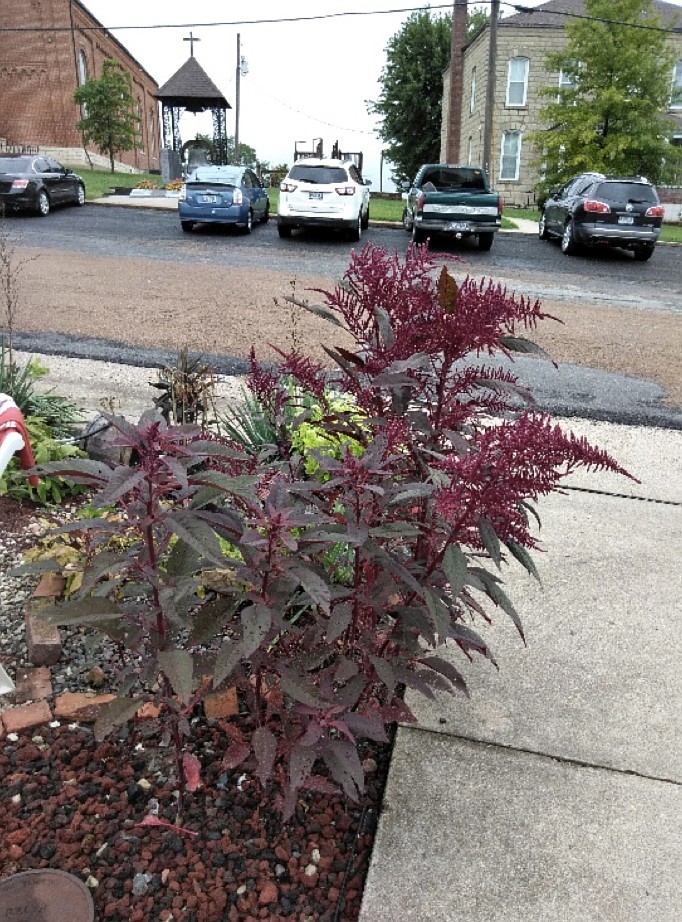Q: What is this lovely red plant? I collect the seed and plant every year. In addition, what can I do to make my peonies look better?
A: Thanks for sending the photos. The red plant is an ornamental type of amaranth, which is in the pigweed family. The common flower celosia is a similar relative.
On the peony, it is likely botrytis blight, and there is a good description on it and how to control by "MO Bot" (Google "Missouri Botanical Garden and peony botrytis blight" and that should get you to it). The most practical ways to prevent begin by cutting all old leaves and stalks down to ground level this fall. This debris should be destroyed and not composted. Apply 1-2 inches of mulch to bury incidental debris. Apply a broad-spectrum fungicide in the spring. Spray the plants when young tips break through the ground. Follow two weeks later with another application and every 14 days thereafter until mid-June. Contact our office if you need specific fungicide recommendations.
Q: Something is eating holes in my azalea leaves. It is a wonderful larger plant. What should I do to make sure it doesn't get worse?
A: I checked several sources of information and could not find any insect mentioned for eating holes in azalea leaves. It is likely either a beetle of some kind or a caterpillar and it probably occurs occasionally, thus doesn't warrant being mentioned as a common pest. Treat the plant now with a broad-spectrum insecticide. There are many to choose from, and some may be more convenient to use - such as attaching a bottle to the end of a hose. Apply again in the spring after flowering and then watch through the summer. Pay special attention toward the end of July and early August; if this is a seasonal pest, it would likely reappear at the same time of year. Treat again if it returns.
Q: I live near Jefferson City and need to do some seeding around a new pond. Where can I get information on what grasses work best and how to manage the pond once it fills with water?
A: Missouri Department of Natural Resources is the best resource for managing and maintaining ponds. It is on its website under a tab about "Your Property." For ponds, the link is mdc.mo.gov/property/pond-stream-care. There is a publication title "Missouri Pond Handbook," which is a 72-page PDF file. Starting on page 17, it addresses important steps following construction and gives general recommendations of what to plant, as well as going into landscaping ideas and considerations. For specific grass or other plants to seed, try contacting the local Soil and Water Conservation District, 1101 Riverside Drive in Jefferson City or call 573-751-4932.
Q: How do I tell when to harvest a watermelon? It is my first time and I've been told different things.
A: The tendril on the vine closest to the fruit turns brown, a discernable spot becomes apparent where it rests on the ground (preferabley white with an obvious shift to some yellowing), and if you wipe your hands across the fruit, you can feel waxy texture (this can be seen with some experience as a whitish haze referred to as a "waxy bloom"). When all three occur, it is assuredly ripe.
Q: How long after top seeding a lawn do I have to wait to apply a broadleaf weed killer to that area?
A: Top seeding is also referred to as "over seeding," meaning spreading seeds over your lawn to increase the density, and is practiced with cool season lawns. It is an excellent cultural practice, but the germination and emergence of this seed is less consistent than on bare dirt. It is important to keep the area watered. A vigorous raking after spreading the seed can also help. Once you see the new seedlings you should wait about two to three weeks to mow. After you have mowed once, you can apply a herbicide that kills broadleaf weeds, which is often referred to as a "lawn herbicide" (kills weeds not the lawn or grass). It would be safest to wait as long as possible. A "Weed and Feed" product is still very effective if applied until mid-October.

